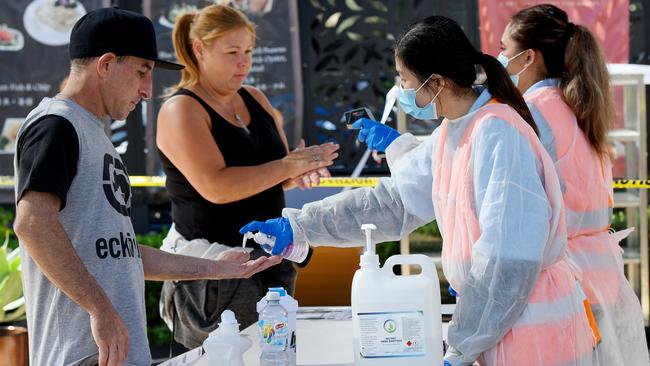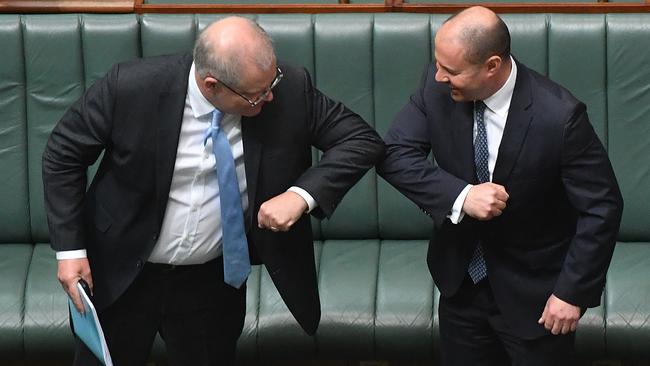Sharri Markson: Will Australia’s great COVID-19 experiment work?
A middle path between eradication and herd immunity could save Australian jobs, writes Sharri Markson.
Opinion
Don't miss out on the headlines from Opinion. Followed categories will be added to My News.
- Embattled NSW minister resigns over holiday home stay
- LIVE GRAPHIC: COVID-19 hammers Sydney’s southwest
When the Morrison government prepared its coronavirus strategy, there were predictions up to 60 per cent of the Australian public could contract the highly infectious disease.
Almost three months since the first confirmed cases of coronavirus were detected on our shores, we are nowhere near this path.
As of Friday, there were 6109 cases in Australia, and 51 deaths.
With our population of around 25.5 million people, that means 0.024 per cent of Australians have had coronavirus.

Australia’s remarkable ability to contain it has led to quite surreal discussions between the federal and state governments about how to change strategy to encourage the spread of the virus among the Australian population.
This is seemingly counterintuitive when you look at New York, Italy, Spain or the United Kingdom, where hundreds of people are dying every day, most spending the final days of their life on their own, in isolation, with no family holding their hands or whispering loving words for comfort.
Not to mention that those who have experienced the severe form of this virus and survived describe the trauma of struggling to breathe as like drowning.

Yet there are now live discussions about easing restrictions to increase the number of Australians contracting the disease, particularly healthy people who are more likely to recover without hospitalisation.
“We are caught between two strategies,” a senior government source explained.
“You either take the path of eradication, like New Zealand, or you take the path of ‘flattening the curve’, which is to allow it to go through your community.
“We are in between those two because our numbers are so low.”
This conundrum has led the government to pursue a new strategy. It is unofficially being dubbed as a “live with the virus” approach.

This is about managing the virus and finding a way to function while it is in the community.
This discussion is the current focus of the National Cabinet.
It’s how to move into a “suppression” phase of the virus to keep it at low levels in the community while the economy can operate.
Our leading health experts are contemplating achieving this by opening businesses that young people use, such as gyms, while sending children back to school.
The strong view from Chief Medical Officer Brendan Murphy is that when restrictions are lifted it will need to be done cautiously and gradually to prevent an explosion in new cases and deaths.
School closures will be one of the first restrictions to be lifted.
While the overarching plan will be agreed to at National Cabinet, every state will follow a different path.
There may be scaled-back restrictions in WA and South Australia, which only recorded one new case on Thursday, earlier than in NSW and Victoria, which are still battling community outbreaks.
The states would have strong border closures while starting to re-open their local economy.
It is a similar path to the one taken by South Korea, where people can have a meal at a restaurant and travel to work, but the freedom is balanced by rigorous testing facilities, very strong contact-tracing, and isolation measures.
Prime Minister Scott Morrison spoke to South Korean President Moon Jae-in this week.
Why not pursue eradication?
If there is a hard lockdown for a month or two, it slaughters the economy and Australia would not be able to reopen its borders for two years.
The health advice to the National Cabinet is also that the virus has to “go through the community”.
Improving our economy by easing restrictions would arguably soften the severity of the disastrous social impact of unemployment, from suicide to mental illness, family breakdowns, domestic violence, homelessness and poverty.

The Treasurer, Josh Frydenberg, points out that in our economy, some parts are doing it tougher than others.
The mining, manufacturing and health sectors are still strong while supermarkets and chemists are doing significantly more trade than usual, while consumer confidence numbers are improving.
But exactly when restrictions are lifted will determine how quickly the other areas come back — if at all.
In terms of the health impact of the deadly coronavirus, embracing the early easing of restrictions to encourage more people to contract the virus is a dangerous path to pursue.
Lifting restrictions will not come without significant risk.
There is no question about it — more people will die. More families will lose those closest to them.
You only have to look at New York, where 799 people died on Friday night, for this to instil fear into your heart.
Our health authorities are playing with fire if they think that they can control the rate of infections once restrictions are lifted.
Only a week spent down the herd immunity path in the UK, where Boris Johnson decided to allow the virus to sweep through the population, may have cost that country thousands of lives.
“It’s trial and error,” the senior government source admitted.
“It’s a live experiment. Not one country in the world knows how to get out effectively because no one is down the road far enough.”
The difference between the “living with the virus” approach the Australian government is now pursuing and herd immunity is that it’s encouraging people in dramatically lower numbers to get the virus.
If there are outbreaks in certain areas, tough restrictions will be reintroduced in those areas.
It’s a buying-time strategy before a vaccine or treatment is found.
While there has never been a vaccine for a coronavirus before, it’s also the case that the world’s medical might has never been so singularly focused on a specific outcome.
As we celebrate Easter and Passover, let’s pray by this time next year our scientists will have achieved a medical “miracle” for this pandemic destroying lives and economies.
